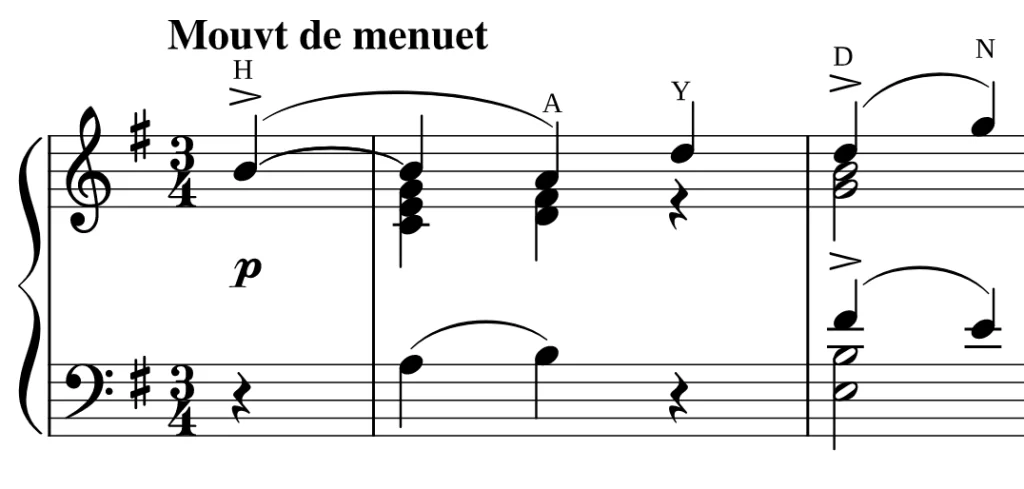音樂與文字的融合,產生的是超乎想像的魅力!本文將以德布西的《紀念海頓》和拉威爾的《依海頓之名的小步舞曲》為例,探索兩位大師如何透過音樂字母法創作出獨特的鋼琴作品。讀者將能深入理解這兩部作品的創作背景,音樂特色,以及其所體現的藝術交融~~
鋼琴家嚴俊傑形容拉威爾與德布西的差別:「小時候我比較親近拉威爾的音樂,因為它非常細緻,就像精美的瓷器一樣,上面還有雕花。但年紀愈大我卻愈喜歡德布西,他不羈,但不狂放,這種境界讓人神往。」
《紀念海頓》介紹
當時國際音樂學會月刊(Revue musicale mensuelle de la Société Internationale de Musique),共委託了六位作曲家來創作紀念海頓的曲子,分別是(Claude Debussy、Maurice Ravel、Paul Dukas、Reynaldo Hahn、Vincent d’Indy、Charles-Marie Widor)
這兩部獨特且精緻的作品,德布西的《紀念海頓 Hommage à Haydn 》(可能又稱為海頓頌、海頓頌歌)和拉威爾的《依海頓之名的小步舞曲 Menuet sur le nom d’Haydn 》都以海頓名字中的五個字母(H-A-Y-D-N)作為音樂主題,且都是為鋼琴獨奏創作,並於1909年(海頓1732-1809,剛好過世了一百年)完成,是兩位作曲家對海頓的致敬之作。
音樂字母法
音樂字母法通常指的是將音符和字母相關聯的方法。在一些歐洲國家的音樂傳統中,特定的字母對應於特定的音符。以下是一個最常見的對應關係表:
- A = A
- B = B (或者在德語系國家,B = B flat,H = B natural)
- C = C
- D = D
- E = E
- F = F
- G = G
- H = B Natural (僅在德語系國家)
除了A到G的七個字母外,其他的字母不直接對應到音符。但在某些音樂作品中,作曲家可能會創新地用某種方式來將這些字母對應到音符,像是用循環的方式排列,Y就對應到D,N對應到G。

德布西『紀念海頓』
德布西的《紀念海頓》是一首明麗且極具特色的鋼琴小品,充滿了空靈、抽象的氛圍。
《紀念海頓》的開頭展現出一種渾沌不明和憂鬱的氣氛。這可能是德布西以音樂的方式,表達對海頓過世的哀悼和對其音樂遺產的尊重。在這裡,會聽到模糊不清的和弦、錯綜複雜的旋律線條以及複雜而富有表現力的節奏。

作品在繼續進行中突然發生轉變,變成了一段充滿活力和熱情的樂章。在這裡,你會聽到音樂的節奏加快,音樂的氣氛也變得更加明亮和熱烈,這段音樂猶如一道閃電。
然而,這種奔馳飛舞的熱烈氣氛最終還是消逝在空氣之中。在作品的結尾,音樂再次變得安靜而憂鬱。德布西以他的音樂語言,將我們帶回到作品的開頭,營造出一種強烈的懷舊和感傷的氣氛。音樂的尾聲結束在一片寂靜之中,只留下深深的悲傷和惆悵。
在其音樂語言中,可以感受到德布西的印象主義風格,像獨特的和聲技巧、對顏色的敏感度和對非傳統節奏結構的使用。在結構上,有如一首慢板的引子與活躍的樂段的結合,這可能是對海頓的讚揚,因為海頓擅長在交響樂的第一樂章中創造出這種形式。
IMSLP:連結
WIKI:連結
拉威爾『依海頓之名的小步舞曲』
拉威爾的作品風格常帶有新古典主義的元素,這在「依海頓之名的小步舞曲」中尤為明顯。拉威爾也以海頓名字中的五個字母(H-A-Y-D-N)分別對應到音樂中的五個音符,形成了該作品的音樂主題。
此作品的旋律線條簡單明快,節奏鮮明有力,充分展現了拉威爾的音樂語言:對音色細節的精緻追求,對旋律和和聲的細膩處理,以及對結構與細節的嚴謹把握,表現出他對巴洛克和古典音樂傳統的理解。
拉威爾的「依海頓之名的小步舞曲」結構簡單,由A-B-A的三部分組成。A部分是以HAYDN主題為基礎的旋律,B部分是中段變奏,對主題進行了多種變奏和改編,然後回到A部分的主題旋律,形成完整的音樂結構。
IMSLP:連結
Wiki:連結
歡迎按讚留言分享!你的支持就是我的最大動力!
看更多古典音樂相關文章?歡迎到RosyArts古典音樂專屬頁面:連結
延伸閱讀:
德布西的《沉沒的教堂》—— 探索深海的伊斯古城 | 創作背景與音樂分析

